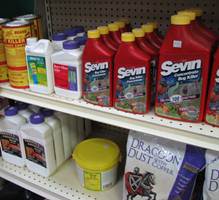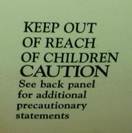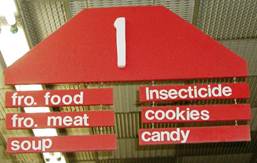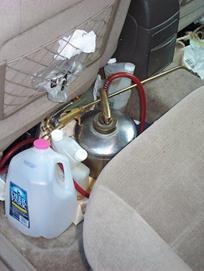Pesticide Safety
 Pesticide safety begins before a pesticide is purchased or used or before a professional is hired. In fact, it could mean not using a pesticide as a means to manage a pest issue. This statement may seem odd appearing on a website devoted to pesticide safety, but it is true nonetheless. Why? Pest management does not always involve the use of pesticides. Many pests are mere nuisances and present no imminent danger or threat to people or their environment. Some pests are easily managed by simple physical removal from the infested area. Quite often, when people encounter an organism that they consider a pest their first thought goes to chemical control. In some situations, they might even consider a mechanical control such as traps for mice but what about the other options.
Pesticide safety begins before a pesticide is purchased or used or before a professional is hired. In fact, it could mean not using a pesticide as a means to manage a pest issue. This statement may seem odd appearing on a website devoted to pesticide safety, but it is true nonetheless. Why? Pest management does not always involve the use of pesticides. Many pests are mere nuisances and present no imminent danger or threat to people or their environment. Some pests are easily managed by simple physical removal from the infested area. Quite often, when people encounter an organism that they consider a pest their first thought goes to chemical control. In some situations, they might even consider a mechanical control such as traps for mice but what about the other options.
When considering pesticide safety people need to first ask themselves two questions: 1. Is the pest really a problem or could it be tolerated? And 2. Do you really need a pesticide or is there some alternative control option? These are very relevant questions since the answers will determine how much if any pesticide is used to manage a pest. These questions should be some of the first ones asked when determing an integrated pest management (IPM) plan. IPM practices reduce and in some cases eliminate the amount of pesticides used by applying cultural, biological, or mechanical controls when possible. In some cases, IPM may mean tolerating a pest to some degree if it poses no threat to human health or their environment. In other situations, it may mean that no pesticides will be used. More general information about Integrated Pest Management practices can be found here. The specific pest management resources presented on this website provide information on how to apply IPM practices for the specified pest.
 If after considering alternative IPM practices, it is determined that a pesticide will be used, then there are other safety considerations that are addressed on the pesticide label. It is important to read and follow the label of any pesticide in order to protect yourself, others and the environment. This begins at the place of purchase. When purchasing pesticides, pay attention to the signal word which appears on the label. The label of every federally registered pesticide may contain one of three different signal words: Caution, Warning or Danger. Products which bear the word “Caution” present the lowest risk to the user and their environment. These products should be used whenever possible to reduce the risk to the users, bystanders and the environment.
If after considering alternative IPM practices, it is determined that a pesticide will be used, then there are other safety considerations that are addressed on the pesticide label. It is important to read and follow the label of any pesticide in order to protect yourself, others and the environment. This begins at the place of purchase. When purchasing pesticides, pay attention to the signal word which appears on the label. The label of every federally registered pesticide may contain one of three different signal words: Caution, Warning or Danger. Products which bear the word “Caution” present the lowest risk to the user and their environment. These products should be used whenever possible to reduce the risk to the users, bystanders and the environment.
Regardless of the signal word, only use a pesticide for the sites or plants which appear on the label. Pesticides labeled for outdoor areas should not be used indoors unless permitted by the label. Never apply a pesticide to a water body or standing water unless that use is permitted by the label. Additionally, only use a pesticide for the type of pest it is intended to control. A disinfectant may kill microscopic “bugs” but it is not intended to kill insects.
Pesticide labels also contain information about how to minimize risks to the user, other people, animals and the environment. This information is found in the Precautionary Statements section of the label. The Environmental Hazards section describes the impact of the product on plants, animals, fish or other organism as well as specific environmental hazards. It may also provide instructions about how to reduce risks to a specific organism or environmental system. For example, some insecticides which are highly toxic to honeybees limit when they are applied to periods when plants are not in bloom. The labels of some agricultural chemicals limit how close they may be applied to wells.
For personal protection, pay attention to the Personal Protective Equipment (PPE) requirements which appear on the label. This section specifies what, if any, special types of clothing are required when mixing or applying the pesticide. This clothing will prevent the pesticide either contacting the skin, spraying into the eyes or from being inhaled during the application. The type of PPE will vary from product to product depending on the products’ toxicity so it is important to review the label and make sure that any necessary PPE is used. Some common pieces of personal protection equipment include eye goggles, chemical resistant gloves or a respirator designed for use with pesticides. Even if PPE is worn, always wash your hands after handling pesticides and before activities such as eating, drinking, chewing gum, smoking or using the bathroom. The First Aid section of the label provides information if the product comes into contact with the body.
One of the most prominent precautionary statements found on the label is “Keep Out of Reach of Children”. Storage areas need to be examined to determine whether they are designed to prevent children from handling pesticides. Ideally, these storage areas would have a lock which could not be easily undone by a child. If no lock is available, pesticides could be stored on a shelf or in a cupboard at a height which is too high for any children to reach. If pesticides are stored on shelves, make sure they will not easily be knocked off or moved. More information about protecting your children can be found on EPA's webpage titled Reduce Your Child's Chances of Pesticide Poisoning.
 Child safety is not the only safety consideration for storing pesticides. Examine the pesticide containers for cracks or tears as these could result in spilled material. If a container is cracked, the material may be moved into another similar container. If possible, attach the original label to the container otherwise write the name of the product, EPA Registration Number and signal word on the container so it will be easily identified. Never use food or beverage containers for pesticide storage. Similarly, pesticides should not be stored with food products. In case, children (and some adults) may mistakenly believe the pesticide is a food and consume it. If pesticide poisoning occurs, contact poison control or your doctor for treatment advice.
Child safety is not the only safety consideration for storing pesticides. Examine the pesticide containers for cracks or tears as these could result in spilled material. If a container is cracked, the material may be moved into another similar container. If possible, attach the original label to the container otherwise write the name of the product, EPA Registration Number and signal word on the container so it will be easily identified. Never use food or beverage containers for pesticide storage. Similarly, pesticides should not be stored with food products. In case, children (and some adults) may mistakenly believe the pesticide is a food and consume it. If pesticide poisoning occurs, contact poison control or your doctor for treatment advice.
Typically, labels will instruct that pesticides are stored in a cool, dry, well ventilated place where there will not be extreme temperature changes. Extreme temperatures can affect not only the pesticide, but also the container in which it is stored. High heat can result in increased vaporization of liquid pesticides. These vapors can present an inhalation hazard. Proper ventilation can reduce the amount of vapors present in the storage area as temperatures increase. High heat can also cause pressure to build up in some containers and breakage to occur. More information about storage conditions can be found here.
Consumers need to clean up any pesticide spills according to the product label not only when they occur in the home or yard but also in storage areas. Residues from spills may get on other items in the storage area or, if on floors, be tracked to other areas thereby creating additional potential for exposure. Clean up directions will vary depending on the type of pesticide that is used so read the label and be prepared for any necessary clean ups. Remember to wear any personal protective equipment (PPE) required by the label during cleanup and disposal. More information on cleaning up spills can be found here.

Each of the previous points needs to be considered when transporting pesticides as well. Ideally, the pesticides should not be transported in the same space where the driver and passengers ride. The chance of exposure to the occupants of the vehicle will be greater, especially if the pesticides have been mixed or opened. In case of spills, either place the pesticides into a plastic tray or place a piece of plastic or tarp material beneath them to keep pesticide residue off of vehicle upholstery or carpeting. During periods of extreme temperatures, don’t leave pesticides in the passenger area or trunk of a vehicle except when in transport or for very short periods of time. Move them into a suitable well ventilated storage area as soon as possible. Vapors from pesticides present an inhalation hazard and become more intense as the temperature increases. Even in a trunk, vapors can move into passenger areas. Again, placing pesticides into a sealed storage compartment will help minimize the hazards created by vapors. There have also been new stories of aerosolized pesticides exploding in vehicles due to increased pressurization caused by extreme heat.
Additional Resources:
Videos from Washington State University
Homeowner's Guide to Pesticide Safety (~19 min)
Pesticide Transportation Day (~8 min)
Pesticide Storage (~12 min)